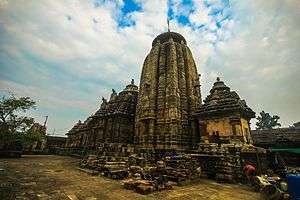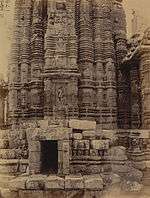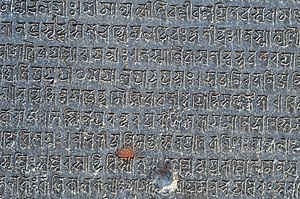Ananta Vasudeva Temple
Ananta Vasudeva Temple (Odia:ଅନନ୍ତ ବାସୁଦେବ ମନ୍ଦିର) is a Hindu temple dedicated to Lord Krishna, an avatar of Lord Vishnu located in Bhubaneswar, the state capital of Odisha, India.[1] The temple was constructed in the thirteenth century, and the complete murtis of Krishna, Balarama and Subhadra are worshipped there. Balarama stands under a seven hooded serpent, Subhadra holds Jewels pot and lotus in her two hands keeping her left foot over another jewel pot, while Krishna holds a mace, chakra, lotus and a conch. The temple dates back to the period of Chandrika Devi, the daughter of Anangabhima III, during the reign of the king Bhanudeva.
| Ananta Vasudeva Temple | |
|---|---|
   The Ananta Vasudeva Temple | |
| Religion | |
| Affiliation | Hinduism |
| District | Khurda |
| Deity | Ananta Vasudeva(Krishna) |
| Location | |
| Location | Bhubaneswar |
| State | Odisha |
| Country | India |
 Location in Odisha | |
| Geographic coordinates | 20°14′26.18″N 85°50′8.81″E |
| Architecture | |
| Completed | 13th Century |
Legend
It appears that the original image of Vishnu was worshipped on the spot where the great temple of Ananta Vasudeva was built in the 13th century A.D. Thus in the 13th century, Queen Chandrika of Eastern Ganga dynasty was prompted to construct a new temple - the temple of Ananta Vasudeva in this place. There must have been an old temple where this Vishnu image was installed. The Marathas, who extended their empire up to river Mahanadi, were responsible for renovating the Vishnu temple at Bhubaneswar in the late 17th Century.[2]
Architecture
In form, the temple resembles the Lingaraj temple, but includes vaishnavite (Lord Vishnu related) sculptures.[3] The temple has longitudinal bands of miniature shikharas (shrines), exactly like those in Lingaraj temple, with the minor difference that the number of the shikharas forming one longitudinal band in its case is only three.[4] The sculpture in the exterior walls varies in character in each temple in Bhubaneswar. Most of the female sculptures in the temple walls are overly ornamented and lack originality[5]
Difference from Jagannath Temple, Puri
The idols found in the garbhagrha (sanctum sanctorum) of the temple have complete structure unlike the images of the Jagannath Temple, Puri. Here the shrimurtis (idols) are made of black granite stone, rather than wood, as seen in the Puri temple. For this temple only the city gains its name as Chakra kshetra (circular place), whereas Puri is named Shankha kshetra (curved place).
Gallery
 View of Ananta Vasudeva Temple from Bindusagar
View of Ananta Vasudeva Temple from Bindusagar View of Ananta Vasudeva Temple in 1869
View of Ananta Vasudeva Temple in 1869 Mahaprasad in Ananta Vasudeva temple
Mahaprasad in Ananta Vasudeva temple Lion statue in the singhadwara
Lion statue in the singhadwara A small broken shrine in the premises
A small broken shrine in the premises First stone inscription installed in the outer wall
First stone inscription installed in the outer wall Bimana or Deula
Bimana or Deula Jagamohana
Jagamohana Abadha and Prasada offered to the deities
Abadha and Prasada offered to the deities The temple kitchen of the Ananta Basudeba temple in Bhubaneswar, Odisha
The temple kitchen of the Ananta Basudeba temple in Bhubaneswar, Odisha The temple kitchen of the Ananta Basudeba temple in Bhubaneswar, Odisha
The temple kitchen of the Ananta Basudeba temple in Bhubaneswar, Odisha
References
| Wikimedia Commons has media related to Ananta Vasudeva Temple. |
- Ghurye, G.S. (2005). Rajput Architecture. Popular Prakashan. p. 91. ISBN 81-7154-446-0.
- Tāntric art of Orissa .P.126.Jitāmitra Prasāda Siṃhadeba.
- Hinduism and the Religious Arts .p.149. Heather Elgood
- Rajput Architecture .p.126.G.S. Ghurye
- World heritage monuments and related edifices in India P.186.ʻAlī Jāvīd, Tabassum Javeed.